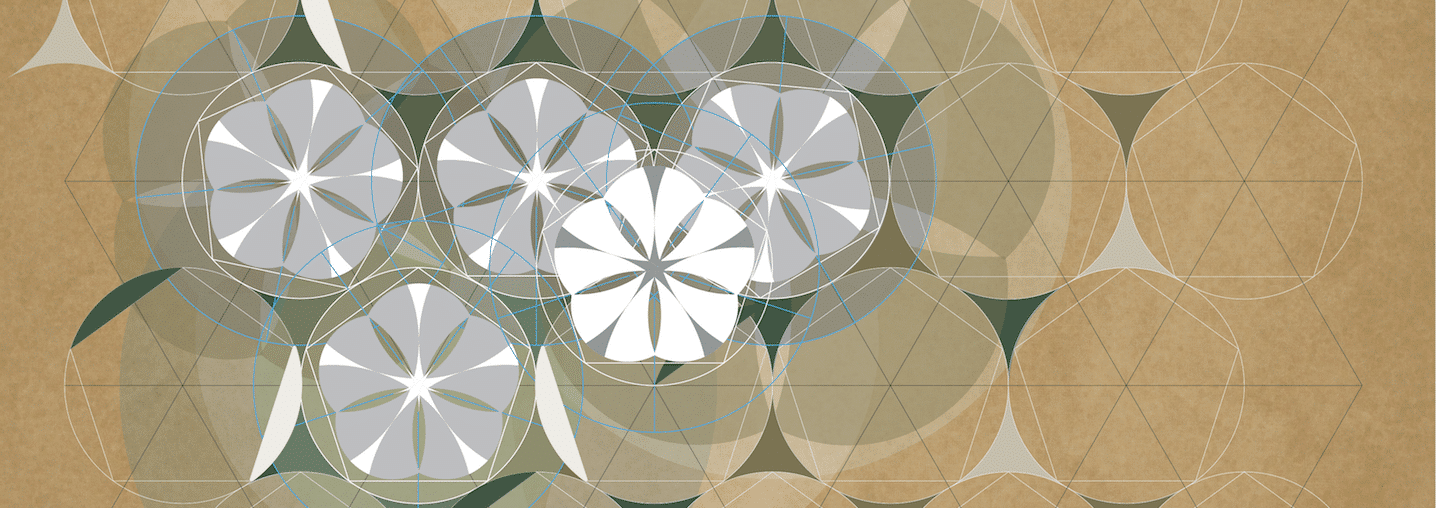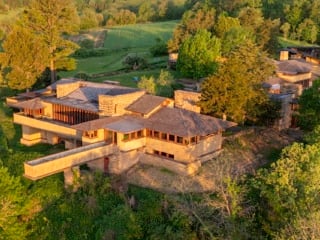
Some Flowers for Architect Frank Lloyd Wright: Wright and Music
Aris Georges | Jan 10, 2018
A conversation with Effi Casey and Tim Wright about Frank Lloyd Wright’s love of music, mathematics, and nature.

Header image: Nature Patterns abstraction evoking the title of the article, “Some Flowers …” by Aris Georges. Image courtesy of Aris Georges. Above: Effi Casey conducting the Taliesin Chorus in the Hillside Theater. (Photo by Dick Ainsworth)
This title is borrowed from the Dutch publication “Wendingen” on the work of Frank Lloyd Wright, published in 1925 — a beautiful book that Wright kept on his desk perpetually. In the opening of the book, publisher Hendrik Wijdeveld wrote a preface called “Some Flowers for Architect Frank Lloyd Wright,” in which he wrote, “Out of the distance comes that which is near, out of rest comes that which is in motion. Trees rise up from the field, mountains from the valley. All is a picture of growth and unity. Eternally changing forms manifest the same wonderful secret of Nature…”
Wijdeveld’s poetic metaphors appear to describe Wright’s architecture and its rise in abstract terms, capturing both contradiction and resonance, and, in a Zen-like way, pointing to the perennial, the unchanging, the Principle of Nature. During the recent celebration of Wright’s 150th birthday in June at Taliesin in Wisconsin, Effi Casey, the longtime Taliesin director of music, fine violinist, and artist; and Tim Wright, a filmmaker, thinker, faculty at the School of Architecture at Taliesin — and a grandson of Frank Lloyd Wright — made remarks on the occasion, and played beautiful music, that moved me deeply. The musical offerings in the life at Taliesin resemble the offering of flowers as symbols of love and appreciation. This inspired me to ask Effi and Tim about their experience of music and architecture. The result yielded deep insight into Wright’s understanding of music and how this shaped his life, and is offered here as a gesture of appreciation of the 150th anniversary.
Aris Georges: Effi and Tim, what can be said, this moment, about music in the context of the community created by Frank Lloyd Wright?
Tim Wright: Well, I played music in the living room on Saturday nights like everybody else who could play an instrument. The one thing I remember soloing was “Dance of the Princesses” from Stravinsky’s “The Firebird” suite, adapted for piano and clarinet — apprentice Curtis Besinger was on the piano. It seemed the music was well beyond Wright’s interest, even as a composition, but he was remarkably tolerant of any level of performance. He loved the structure of the music itself, just the fact that it was music.
Effi Casey: When I work with the chorus, I am aware that I’m not a professional conductor, let’s say, I never learned that. But I do it for the love of it and I give it my best. I understand the music and can convey it and so.
TW: You create the love in the people you are conducting, Effi.
EC: Yes, I’m very moved by it, people sometimes clap during rehearsal. That’s so moving! Here is something profound in play which is bringing people together in a shared experience.
AG: So, you both seem to point to a kind of connection to music that is informal, personal—something more significant than the notes themselves.
EC: Is it not fair to say that Wright appreciated the amateur? The word amateur holds the word “amare,” meaning “love.” So, doing something for the love of it doesn’t necessarily mean incompetence. I think Wright really appreciated someone who made an honest effort to do something. In contrast, maybe, to a professional who he often degraded, as such. Here comes, also, Wright’s depth dimension; that you need to go into something to discover it from within and really learn and enjoy something about it.
TW: In architecture, you never understand a Wright building until you have been inside it — from the inside out.
EC: From within outward.
AG: This reminds me of “the Nature of the thing,” a phrase Wright would use to incite looking beyond the surface, the appearances of things, and delve into the deeper layers to find an underlying principle, or even the underlying principles. In this context, how do you see music and architecture?
TW: Wright at some point said that music is a sublimation of mathematics. And he said architecture is the same kind sublimation of mathematics. When inspired by nature, a composer would not use the sounds of a gander, or any kind of an actual, natural sound because to be a composition it needs to be sublimated, he said. It needs to pass through what he called an “alembic,” which was a process of distilling the essence of the natural world into something mathematical and geometric. Architecture does in space what music does in time, which is, similarly, to abstract nature and turn it into notes rather than natural sounds. Architects do the same thing. They distill out of nature something that is not the same as a flower. I always thought it was interesting that this process of distillation, he felt, was the same for music as it was for architecture, and that both were essentially mathematical. Sort of distillations of mathematical relations, and that just makes me think about the architectural music in his work.
EC: I have pointed out to the chorus that in Bach’s B minor Mass—especially the “Dona Nobis Pacem” [Give Us Peace]— you can even look at the score and see the architecture of it, how it is vertically composed and aligned like a structure, like a section you can visually recognize. When you look at the music’s structure, you walk into it as if it were a space, and there it connects to the heart and it puts you in the center of a greater constellation of feelings. All that plays into the interpretation of the music. That’s when you give it life to go way beyond singing the notes.

Frank Lloyd Wright playing the piano in 1955 at Taliesin.
AG: I grew up with an affinity for geometry and in my mind geometry is the same mathematics we are discussing. Geometry is a direct way I can examine or analyze something, and use creatively. When I do nature patterns, or even more so the name abstractions which I call “archifiti,” architectural graffiti, it is a dynamic process with the geometry. For me, it is the equivalent of improvising with music, if I were a musician. I can improvise with the geometric rules; I have learned the inherent properties of every geometric shape. When you bring them together they start creating new properties, not only as a sum of the parts but with new ones that emerge from the relationship. I like to think it is akin to harmony theory, the overtones and resonance in sound harmonics. Of course, the strong geometric tenor of Wright’s work attracted, and attracts, me for its timeless qualities. It is what makes Wright relevant, no matter the time. How can we still be moved by these ideas? Whereas we can see some of his contemporaries, only in historical context and enjoy as such, but without necessarily any present-day relevance.
TW: There is another, more personal side to this relationship of Wright and music. I was very struck by the discontinuity and alienation that Wright had from his father as he cleaved to his mother. Yet he is profoundly influenced by the musical education he got from his father. He was late in high school when they separated. The separation was almost violent, Anna said, “I hate the very ground you walk on, if you only give me the place, you may go where you please.” None of his children by Anna, including Wright, ever spoke to him again or ever went to his gravesite or his funeral so far as we know. Yet, as his mother inspired him to be an architect, it is also true that his father inspired his love of music. There’s no evidence of any musical particularity of the Lloyd Jones clan which dominate biographies of Wright, but his father explained to him that a symphony is like an edifice of sound and that he taught him to play the piano and viola. What strikes me about Taliesin is that it was Wright’s family — his attempt to heal that terrible split between his parents. He integrated his architectural life with his love of music intimately. These two powerful influences in his life which couldn’t be reconciled in actual life were reconciled in a synthesis at Taliesin.
EC: That was the point I took away from your comments at the birthday, that very point. I never thought about it that way.
TW: What he says of his own autobiography about family: “I gave each child an instrument to play and that is all I asked of their education.” My father’s instrument turned out to be the mandolin. My father never really read music, but in moments of introspection, he would always pick up the mandolin and play, but improvise.
EC: Tim, somebody asked me if Wright was a pianist. I said not in the classical sense of the pianist who plays a lot of literature. Is that correct? I have never heard that Wright played Beethoven sonatas, or could he do that?
TW: When I first came to Taliesin, I was put in a room from where I would hear grandfather play but it was very improvisational. It was not reading a composition or anything, it would just be kind of noodling on the piano, but playing very skillfully. Mostly kind of amusing. Almost as if he was thinking musically, rather than interpreting some piece of musical architecture.
In closing, the metaphor of flowers as symbolic gifts reminds me of the little story in Wright’s Autobiography he wrote as the “prelude.” As a young boy on a cold, crisp, sunny early spring day, following his uncle John up a hill near Taliesin, he criss-crossed his uncle’s path to pick up tiny little pasque flowers poking through the snow. At the top of the hill a double lesson ensued: his uncle gently reproved the “indiscipline” of the youthful meandering path, while the boy cherished the armful of flowers.

Aris Georges is a Taliesin Fellow (’86), an architectural and graphic designer, and a design teacher. He served as faculty chair at the School of Architecture at Taliesin for 14 years. At a young age in Greece, Aris was tutored by two practicing architects and developed his strong architectural focus. He studied architecture at the University of Florence, Italy, and received his Master of Architecture from Taliesin in 1992. Later, he was Senior Taliesin Fellow, graphic designer for the Frank Lloyd Wright Foundation, intern architect with Taliesin Architects, and Director of Curriculum at the School. His graduate courses included Advanced Design Studio, Research Design Studio, Graphic Design, Hand Drawing and Rendering, and Nature Patterns. He is currently Art Director at a communications company in Portland, Oregon, and maintains his studio designing custom homes.
This article originally appeared in the Summer 2017 issue of the Frank Lloyd Wright Quarterly, “Section.”



